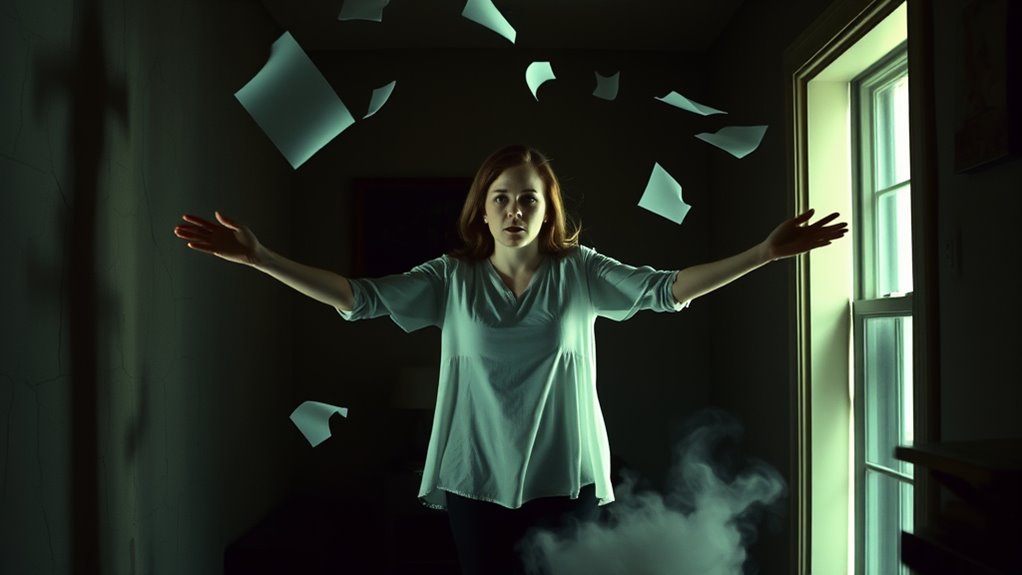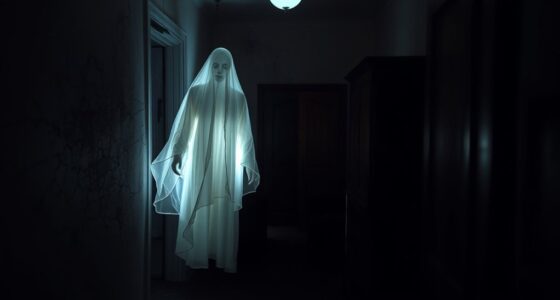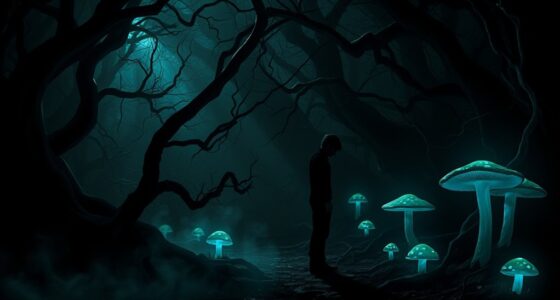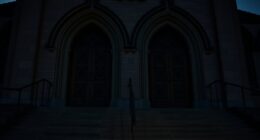The Columbus Poltergeist case involving Tina Resch in 1984 features unexplained physical, auditory, and visual phenomena disrupting her family’s life, with media sensationalism fueling public curiosity and skepticism. Scientific investigations suggest psychological factors like suggestion and mass hysteria, while others view it as supernatural. The case remains debated, highlighting how perception and media shape beliefs. To uncover more details, you’ll explore how these phenomena continue to spark interest and controversy today.
Key Takeaways
- The case involved unexplained phenomena such as flying objects, noises, and physical contact centered around Tina Resch in 1984.
- Media sensationalism amplified public interest, often exaggerating events and fueling belief or skepticism.
- Scientific investigations considered psychological explanations like suggestion, subconscious movements, and mass hysteria.
- Phenomena included luminous discs, loud bangs, whispering, and physical manipulation, with interpretations ranging from supernatural to psychological.
- Cultural influences and media coverage shaped perceptions, leading to polarized views of the case as either genuine poltergeist activity or hoax.
Background and Context of the Resch Family

The Resch family moved into their home in Columbus expecting a fresh start, but soon strange occurrences began disrupting their daily lives. Their family dynamics quickly shifted as tensions grew, with members feeling increasingly unsettled by unexplained events. The neighborhood environment, usually quiet and welcoming, now felt tense and unpredictable. Neighbors noticed the changes, sensing something unusual about the household. The family’s interactions became strained as they tried to understand what was happening. Tina Resch, the youngest member, was often at the center of these disturbances, sparking curiosity and concern in the community. Despite their efforts to settle in peacefully, the eerie atmosphere took hold, making their new beginning feel more like a challenge than a fresh start. The paranormal activity surrounding their home added an additional layer of mystery to the case, captivating the interest of investigators and skeptics alike. Such cases often involve unexplained phenomena, which remain difficult to verify but continue to intrigue both researchers and the public.
Notable Incidents and Phenomena Observed

You’ll notice several striking incidents, like flying objects and strange lights, that defy simple explanation. Unexplained noises echo through the house, often startling the family members. Physical contact events, such as objects moving or being touched unexpectedly, add to the unsettling pattern of phenomena. Some reports also mention the use of essential oils to help calm anxieties related to the disturbances. Additionally, the phenomena observed can be linked to dreaming as a natural part of healthy sleep cycles, which may influence perceptions and memories of such events. The presence of paranormal activity has been a point of investigation, with some suggesting psychological factors could also play a role. Exploring famous cases like this one can help deepen our understanding of such extraordinary events. Moreover, understanding the cycle of breakups in relationships can shed light on how emotional disturbances might influence perceptions of reality and heighten sensitivity to unexplained phenomena.
Flying Objects Manifestations
Numerous reports from witnesses describe luminous, disc-shaped objects darting across the night sky during the Columbus poltergeist events. These flying objects seem to align with the poltergeist dynamics, adding a layer of complexity to the paranormal phenomena. Witnesses often describe these crafts as glowing or shimmering, moving unpredictably and sometimes stopping abruptly. Some accounts suggest they hovered near the house before vanishing suddenly. The appearance of these objects coincides with heightened activity inside the Resch household, raising questions about their connection to Tina’s experiences. While skeptics argue these sightings could be optical illusions or misidentified aircraft, believers see them as tangible evidence of supernatural forces at play. These flying object manifestations remain one of the most intriguing facets of the Columbus poltergeist case. Unexplained phenomena continue to fuel debates about their true nature and origin, especially given the global influence of such reports in popular culture. Additionally, some researchers speculate that these sightings might be linked to paranormal energies, which are often associated with intense poltergeist activity. The consistent reports of these objects across different accounts suggest a potential supernatural connection that warrants further investigation.
Unexplained Noises Occurrences
Witnesses reported a series of unexplained noises that often accompanied the flying object sightings, intensifying the sense of mystery surrounding the Columbus poltergeist. These sounds ranged from loud bangs and knocking to whispering voices, suggesting possible paranormal communication. Some witnesses described hearing auditory hallucinations, feeling as if unseen forces were trying to communicate or intimidate them. The noises seemed to occur randomly, often without any apparent source, adding to the eerie atmosphere. Investigators found it difficult to explain these phenomena through conventional means, leaving questions about whether they were genuine auditory hallucinations or part of a larger supernatural event. The unexplained noises contributed markedly to the overall enigma of the poltergeist activity, fueling speculation about unseen energies at play. Additionally, auditory hallucinations have been studied in relation to various paranormal reports, though their true nature remains uncertain.
Physical Contact Events
Several reports describe instances where individuals experienced direct physical contact with mysterious entities or objects during the Columbus poltergeist phenomena. These poltergeist manifestations often involved objects moving suddenly or appearing to be manipulated by unseen forces, but some incidents went further with actual physical contact. Witnesses, including Tina Resch, reported being pushed, touched, or grabbed during episodes of intense activity. In one notable incident, Tina claimed to be physically assaulted by unseen hands, leaving marks or causing discomfort. Such episodes suggest that the poltergeist not only manifests through objects but also interacts physically with those nearby. These events challenge rational explanations and deepen the mystery surrounding the phenomena, highlighting the unsettling nature of the physical contact involved in the case. The phenomenon’s physical contact incidents remain difficult to explain through conventional scientific understanding, fueling ongoing debates about their true nature.
Media Coverage and Public Reaction

Media coverage of the Columbus Poltergeist often sensationalized the events, shaping public perceptions and fueling curiosity. As stories spread, skepticism grew among those questioning the authenticity of the phenomena. These reactions ultimately shifted cultural attitudes toward paranormal incidents in the community. Additionally, the widespread sharing of cultural content related to the case played a role in influencing public opinion and fostering community discussions. The influence of media portrayal can significantly impact how such cases are perceived by both the public and authorities. Moreover, the case highlighted the importance of AI algorithms in analyzing and understanding media narratives, which can help discern fact from fiction in sensationalized stories.
Media Sensationalism Effects
The sensational coverage surrounding the Columbus Poltergeist rapidly amplified public interest and skepticism alike. Media bias and sensational journalism played significant roles in shaping perceptions, often prioritizing dramatic stories over factual accuracy. Headlines exaggerated events, making Tina Resch’s experiences seem more extraordinary, which drew more viewers and readers. This sensationalism heightened public curiosity but also fueled doubts, as many questioned whether the media’s focus was on uncovering truth or simply attracting attention. The media’s emphasis on the mysterious aspects overshadowed the nuanced investigation, leading to a polarized audience. As a result, the story became less about understanding the phenomena and more about sensational spectacle, illustrating how media bias can distort public perception and hinder objective analysis of paranormal claims.
Public Skepticism Rise
As coverage of the Columbus Poltergeist intensified, public skepticism grew alongside curiosity. People started questioning the authenticity of the events, fueled by concerns over media bias and sensationalism. Many skeptics demanded scientific evidence, challenging the narratives pushed by sensational media outlets. The controversy sparked debates about whether Tina Resch’s claims were genuine or manipulated.
You might notice that:
- Media outlets often prioritized sensational stories over objective investigation
- Scientific skepticism called for rigorous testing before accepting supernatural explanations
- Public opinion split between believers and critics, with some viewing it as a hoax or psychological issue
This atmosphere of doubt reflected a broader trend of skepticism toward paranormal claims, emphasizing the need for critical analysis and reliable evidence beyond media hype.
Cultural Impact Shifts
Have coverage of the Columbus Poltergeist truly shifted public perception? Media influence played a key role in shaping how people viewed the phenomenon. Early reports sensationalized Tina Resch’s case, fueling curiosity and skepticism alike. Over time, media portrayals ranged from genuine belief to outright debunking, impacting cultural perception of poltergeist activity. As coverage spread, society became more polarized: some saw it as evidence of supernatural forces, while others dismissed it as hoax or psychological disturbance. This shifting narrative influenced public reactions, fostering both fascination and doubt. Ultimately, media coverage steered the conversation from outright skepticism to a more nuanced understanding, highlighting how media influence can dramatically alter cultural perceptions of paranormal events.
Scientific Investigations and Explanations

Scientific investigations into the Columbus Poltergeist aim to uncover rational explanations for the phenomena reported. You’re encouraged to contemplate scientific skepticism, which questions supernatural claims and emphasizes empirical evidence. Researchers examined Tina Resch’s claims through various methods, including interviews and video analysis. They explored possible psychological explanations, such as the power of suggestion or unconscious muscle movements, that could produce the observed events. Investigators also looked for signs of deception or manipulation. To deepen understanding, they considered:
- The role of stress and attention-seeking behaviors
- The influence of environmental factors or accidental triggers
- The potential for subconscious physical movements to mimic poltergeist activity
These efforts aim to determine whether the phenomena stem from psychological factors or other rational causes.
Psychological Perspectives and Theories

Psychological perspectives offer valuable insights into the Columbus Poltergeist phenomena by exploring the mental and emotional factors that could influence reported events. You might consider how mass hysteria could cause collective belief in supernatural activity, fueling the phenomenon. Cognitive biases, like confirmation bias, can lead you to interpret ambiguous events as paranormal, reinforcing the belief. Here’s a quick overview:
| Factor | Explanation |
|---|---|
| Mass Hysteria | Shared psychological response causing widespread excitement or fear. |
| Cognitive Biases | Mental shortcuts that distort perception and reinforce beliefs. |
| Emotional State | Stress or anxiety can heighten susceptibility to suggestive influences. |
| Social Influence | Peer and media influence shape perceptions and narratives. |
These factors help explain how psychological processes shape the reports and perceptions surrounding the poltergeist.
Impact on Paranormal Research and Skepticism

The Columbus Poltergeist case has considerably influenced both paranormal research and skepticism by highlighting the importance of critical analysis and scientific inquiry. It underscored how media influence can shape public perception, often blurring the lines between credible evidence and sensationalism. As a result, researchers began emphasizing rigorous research methodology to distinguish genuine phenomena from hoaxes or psychological factors. This case prompted skeptics to question claims more thoroughly, fostering a more cautious approach within the field. Conversely, it encouraged some paranormal investigators to refine their techniques, aiming for greater objectivity. Overall, the case served as a pivotal reminder that scientific skepticism and methodological rigor are essential for advancing understanding and maintaining credibility in paranormal research.
Ongoing Debates and Unresolved Questions

While the Columbus Poltergeist case prompted significant changes in research approaches, it also left many questions unanswered, fueling ongoing debates within the field. Skeptics argue that the evidence credibility remains questionable, often citing inconsistencies or potential manipulation in Tina Resch’s displays. They challenge whether the phenomena were genuine or the result of psychological factors, attention-seeking, or fraud. On the other hand, proponents believe the case offers compelling evidence for paranormal activity. Unresolved questions about the source of the poltergeist activity and Tina’s motivations persist, keeping the debate alive. This ongoing tension emphasizes the difficulty in separating genuine phenomena from possible hoaxes, highlighting the need for more rigorous, unbiased investigations in future cases.
Frequently Asked Questions
What Was Tina Resch’S Life Like After the Poltergeist Events?
After the poltergeist events, you might feel the psychological impact lingering, affecting your sense of normalcy and trust. Public perception likely shifts, with some viewing you as a phenomenon, which can be overwhelming or isolating. You could struggle with maintaining privacy, dealing with media attention, or questioning your own experiences. These changes often influence your life considerably, shaping how you see yourself and how others perceive you.
How Did Tina’S Family Change Following the Incident?
You notice that your family’s dynamics shift after a shocking event, often feeling more tense or distant. The emotional impact can cause stress and uncertainty, making communication harder. You might see increased conflicts or a need for greater support as everyone processes what happened. These changes can lead your family to become more focused on each other’s well-being, but they might also create lingering feelings of fear or mistrust that take time to heal.
Were There Any Legal Actions Taken During the Case?
You wonder if legal proceedings or court rulings played a role in the case. During the incident, no formal legal actions were initiated, as authorities and courts were skeptical of supernatural explanations. Instead, the focus remained on investigating the phenomena and understanding Tina’s experiences. The case didn’t lead to legal rulings or court cases, emphasizing the challenge of addressing paranormal claims within the legal system.
Has Tina Resch Publicly Spoken About Her Experiences Since?
You might wonder if Tina Resch has made any public statements or appeared in the media since her experiences. She has spoken about her story in interviews and some media appearances, sharing her perspective on what happened. Resch has addressed her past publicly, offering her side of the story and clarifying misconceptions, which helps keep her experiences in public discussion.
What Influence Did This Case Have on Later Paranormal Investigations?
Think of this case as a ripple in the pond of paranormal investigations. It pushed investigators to refine their methodologies and question media skepticism. You see, it challenged skeptics and believers alike, prompting more rigorous testing of claims. As a result, investigators began to develop better protocols, making future investigations more systematic and credible. This case became a catalyst, shaping how the paranormal community approaches evidence and skepticism today.
Conclusion
As you reflect on the Resch family’s story, remember that the poltergeist acts as a mirror—mirroring fears, doubts, and unspoken truths. It challenges you to see beyond the surface, like a flickering candle in darkness, illuminating mysteries that refuse to fade. Whether a haunting or psyche’s shadow, its symbolism invites you to confront the unknown within and around you, daring you to seek understanding in the shadows where questions still linger.









